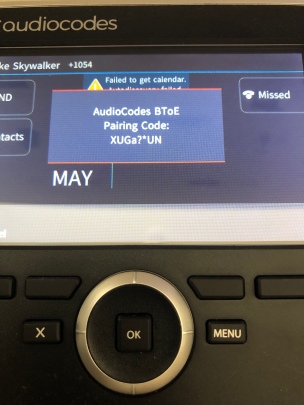llo Readers, I hope you’re well.
This post is a long time coming. Truth be told, I’ve had this phone for a long time. You could say I have been taking it for a long, long test drive. I started to draft my thoughts as soon as I got it and even started a draft of the review. It isn’t my first AudioCodes phone either. I got a 440HD a couple of years ago. I even have a draft of a review of that phone saved on my blog.
I decided to write a new post on the AudioCodes 445HD because a lot has changed since I got it.
First, some background
I’m keen to try any device that supports Skype for Business (or Microsoft Teams). My goal is to try as many devices as possible so I can have an informed opinion when I talk to customers about their UC projects. I write reviews for two main reasons. The primary reason is to help others choose a products for their project. The other is to help the vendors themselves improve their products. I try to be as open and honest as possible about the product and my experience with it.
You will have seen other reviews on my site for handsets, headsets and speakerphones. These are all classed as endpoints. To massively simplify them, an endpoint enables the user to talk and listen when on an audio call.
Choice of endpoint is very subjective. Most users tend to be either handset or handset people. When you work on a project to replace a traditional PBX with Skype for Business, the subject of endpoints will crop up sooner or later. What I find often is that there are some that absolutely can’t do without a handset… at the start. This is because they already had a handset and they don’t know any better. I find that some will embrace change immediately and choose a headset. Others start with a handset and stick with them. Many of those change over time when they see others using headsets successfully.
I always say that if you are going to choose a handset, you should choose a handset that enhances the user experience. It should be intuitive to use. And provide all the features the user needs, at easy reach.
You should also choose a device that is qualified or certified to work with Skype for Business. I’ve covered this at length in a previous post. As you know, Microsoft doesn’t make desk phones. Instead, they have created an ecosystem where anyone can have a go at making a device. The ecosystem is known as the Unified Communications Open Interoperability Program (UCOIP). Vendors of devices, appliances and applications apply to have their stuff certified, by Microsoft, to work with Skype for Business. This often means that the vendors work with Microsoft on developing the device to make sure it supports the set of standards and features required for certification.
Top Tip: Choosing a device that is certified will greatly increase the chances of a quality experience.
It isn’t just about the quality experience they offer, however. While all Microsoft certified 3rd Party IP (3PIP) phones work with Lync or Skype for Business Server, not all of them are qualified to work with Skype for Business Online, which also means they won’t work with Microsoft Teams. Some, just don’t work at all with Skype Online because, they say, Microsoft blocks them (Spectralink). Some won’t work with Skype Online because the technology used in them, just isn’t good enough, or secure enough anymore (Lync Phone Edition). It’s important that what you buy has a future.
AudioCodes
If you’re reading this, you are probably already familiar with AudioCodes. I was first introduced to them when I was installing Lync for a customer and needed a qualified gateway. AudioCodes, in fact, has a huge list of products for Skype for Business from physical and virtual SBCs, gateways and VoIP routers, appliances for Branch Survivability, Cloud Connector Edition and even Skype for Business Server “in-a-box”. They also make applications such as voice recording and phone, appliance and estate management and, of course phones.
This is an old slide clearly, because it is missing some of the newer phones.

I quite like this graphic which is on their website. As I said, you want a product that has a future. It’s equally important that the vendor has pedigree, and a future.
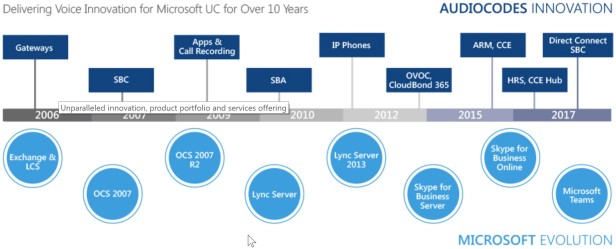
This one shows all of the current phone models which are arranged by price (and features, I’d say).

On with the show.
The Review: AudioCodes 445HD IP Phone for Skype for Business (and Microsoft Teams)

What is it?
The AudioCodes 445HD is a 3rd Party IP Phone which has been certified by Microsoft and is qualified to work with Lync and Skype for Business Server, Skype for Business Online and Microsoft Teams.
It has a 4.3 inch high-resolution colour screen. It has built-in Bluetooth and Wifi, dedicated keys for the most used functions, context sensitive soft keys, 6 programmable multi-function keys and a LCD “sidecar” for displaying your favourite contacts with integrated presence indicators.
- Color 4.3” high resolution screen (480 x 272)
- Full duplex speakerphone and headset connectivity
- 6 multi-function keys
- 4 soft keys
- Dedicated LCD (370 x 60) for 12 contacts with an integrated “Busy Lamp Field” (BLF)
- GbE support
- USB headset support
- PoE or external power supply
- HD Voice (Wideband audio)
Now you have one
Right off the bat, I would say that this phone is just plain easy to use. I have looked over the manual, but that was to find out how to change something that wasn’t obvious. Usability is key, I think you’ll agree. It’s also intuitive. Changing the function of one of the built in function keys or indeed the sidecar keys is as simple as can be.
Simply long press the key you want to change and choose what you want there.

Choose from Speed dial or a Key Event. A Key Event is a key that either performs a function or takes you to another screen. Choose from one of several Key Events.
Missed Calls, for instance, takes you to your missed calls list.
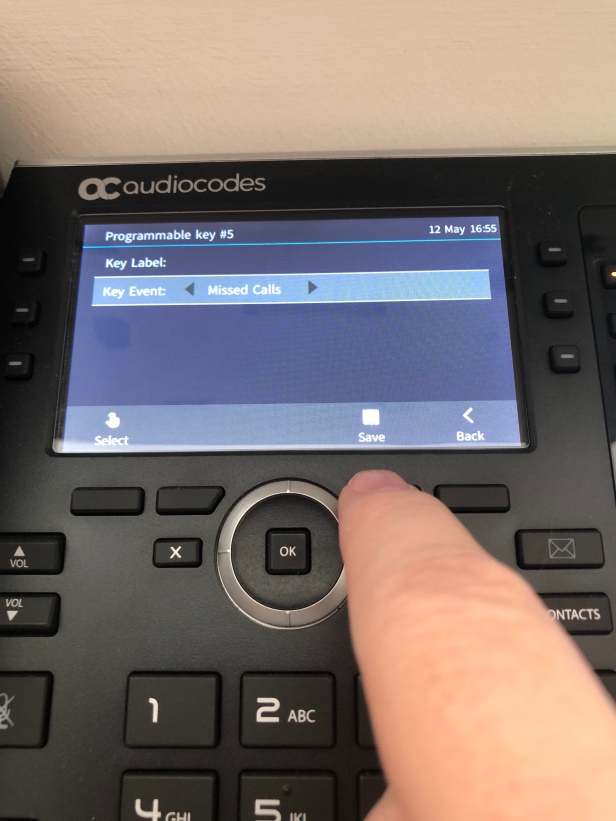
Speed dials are equally easy. Just long press one of the keys on the sidecar and choose speed dial.
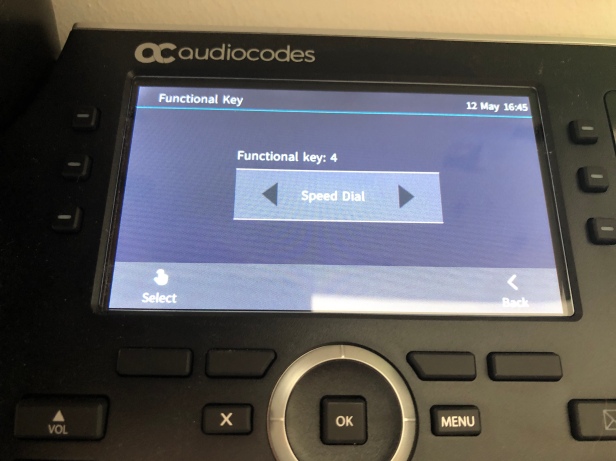
Then enter a name and number or search from the directory.
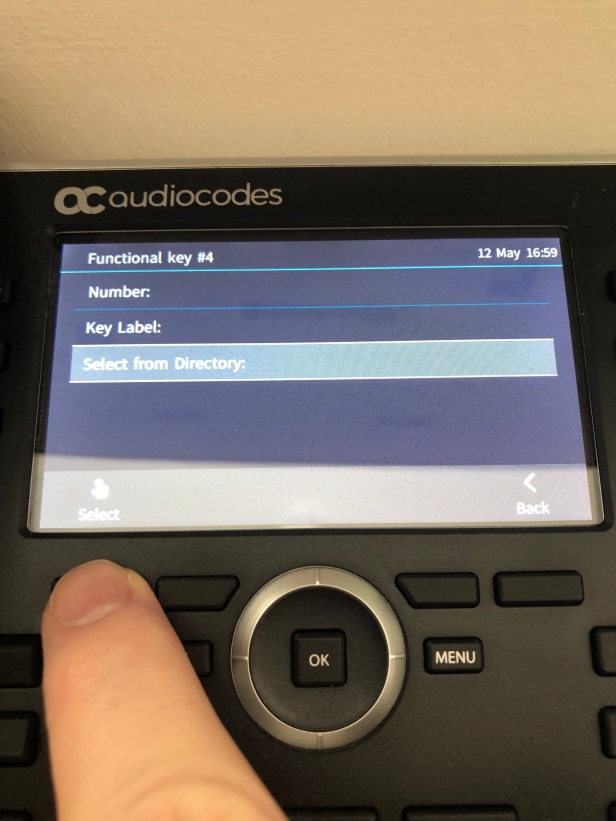
Like most IP phones, there’s a web UI. Simply browse to the IP address of the phone to open the login screen. To get the IP address, tap menu, then status, then network status.


The easiest way to log in to an AudioCodes phone using your full username and password is from the web UI.

You can also change all manner of settings from language, ring tones, timezone and NTP and voice codec.
Most of the AudioCodes phones have built in support for Silk, G.722, 729 and 711 and they support both Wideband and Narrowband.

You can even choose your own priority list (example).
You can also change programmable keys

And function (Sidecar) keys
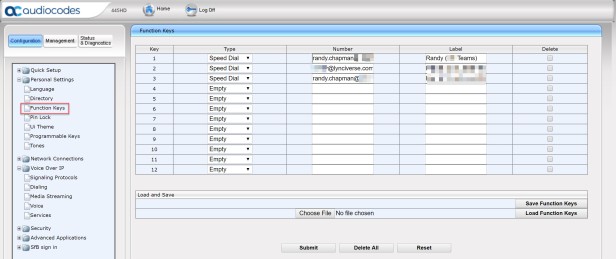
Unfortunately, not all settings are available to change using the Web UI. This is simply because there are so many, they really didn’t want to make a menu page, box or button for each one. If you want to change something you don’t see, you can change it in the config file.
Browse to Management -> expand Manual Update -> click Configuration file
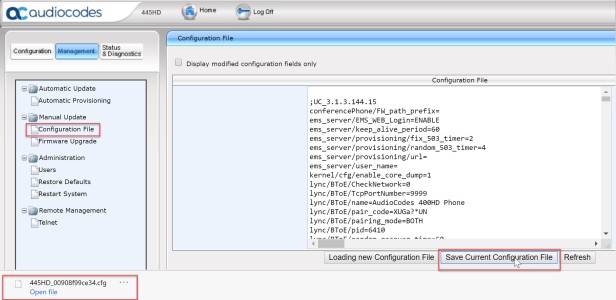
To change something, you need to save the current config file and open it. Add the line or make the change you want and save.
These two changes, for instance

The first, in my opinion, is a must. The dedicated transfer key is set to blind transfer by default. That might suit some, but I always think consulting first is better than a dead drop before you even know if the person wants to take the call.
The second is going to be subjective, but it enables what is called semi-consultative transfer. This is where you can transfer as soon as the far end rings [1] or as soon as they answer the phone [0].
Add, delete or change what you want, then simply load the configuration file. This uploads the file and reboots the phone.
What else is there?
The phone can be used to log in to Skype for Business Server or Online or Teams (via the Microsoft gateway). You can log in from the phone or the web UI using username and password, extension and pin and web login (for Skype Online). You can also authenticate using the Better Together (BToE) application. The BToE client is a system tray application that pairs the desk phone with the Skype for Business client running on your PC. This means you can answer a call using the soft keys on the desktop and use the phone to speak.
To pair your phone, find the AudioCodes BToE system tray app icon, right click and click phone pairing. Then, on the phone press the MENU hardkey followed by the BToE softkey, the BToE pairing code will be displayed.
On the PC enter the phone pairing code in displayed window and press ok.

Once paired, you can set the AudioCodes phone as your default audio device in Skype for Business.
What do I like?
One feature I like is the built in presence light on the phone. An old school touch, but a welcome one.
I like its simplicity and the fact that it is really intuitive. I found out how to change the setting on a key by chance. I guessed that a long press would trigger the request and I was right. That either comes from many years of IP phone use on my part, or the fact that the engineers that designed the experience wanted it to be obvious. or both.
On this particular model (and the 440HD), I like the sidecar. That’s a great touch for any user, but also for a PA or reception. See the status of your favourites at a glance. One touch to dial one of your contacts. And you can tap one of the soft keys to initiate a transfer.
T9 text. This is a feature I have lauded about forever. It was one of the best features of the Lync Phone Edition phones. T9 text input means that the phone try’s to spell a name from the numbers you enter. To spell Mike, for instance, press 6453 because these numbers contain the letters that spell Mike.

The phone searches for users with 6453 and for names that contain the letters.
What would I change?
One of the few things I would change is the process for changing things that aren’t in the UI. Having to download the config file, change and re-upload, then reboot, is fiddly. It would be nice to be able to scroll through the file on the UI screen, edit and press save. On top of that, some things that I think should be in the UI just aren’t there which means I have to change the config file. See transfer options above.
Another change I would like to see is the ability to search using T9 by default, from the idle state. This was probably one of the best features of the old Lync Phone Edition phones and it has been copied by another vendor. What I mean, is enter 6453 from the home screen and the phone starts to search for contacts to choose from. Then presents a list which includes 6453 (as an extension) and all the Mike’s in the directory or your contacts.
It isn’t too bad finding a contact using the dedicated contacts button. And you can search using T9 as the default keyboard. But given that the thing you’ll do most is search and dial, it could be made just a bit easier by saving a couple of button presses. I know I’m being picky here, but it’s a feature I’ve been used to since I started using OCS/Lync as a phone 10+ years ago and it is a feature on other phones in the market. And I know that with BToE, you’ll probably search on your PC, dial and just use your handset to talk.
I had a bigger list for the 440HD that I gave AudioCodes as part of my trial. One of the reasons I didn’t release a post was because the list of gripes was so long I thought it wasn’t fair on them. Some were even more picky probably. But I think I have a knack for spotting things that will annoy end users. I think it is important to be critical. It’s how things are improved. Some of my readers will have had comments back from me when testing their stuff and I know you can attest to that. You know who you are ;).
I’m happy to say that pretty much every niggle I had on my list back then is gone in this phone. The 445HD is similar to the 440, but also very different. Similar form factor and sidecar. But the 440 is grey-scale and with a much smaller screen. The 445HD is much more usable in mu opinion.
The Verdict
I really think the 445HD is a great phone for those that want one. It takes the best features from a good PBX phone and the simplicity of using Skype for Business and combines it into a decent user interface. It is simple to use with not a lot of guess work, simple to manage, and the voice quality is superb. Thanks of course to the use of Skype for Business and Wideband codecs.
More info
If you want to know more about AudioCodes products and services have a look at their website https://www.audiocodes.com/.
If you want to know more about AudioCodes range of IP phones click here or speak to your voice partner.








